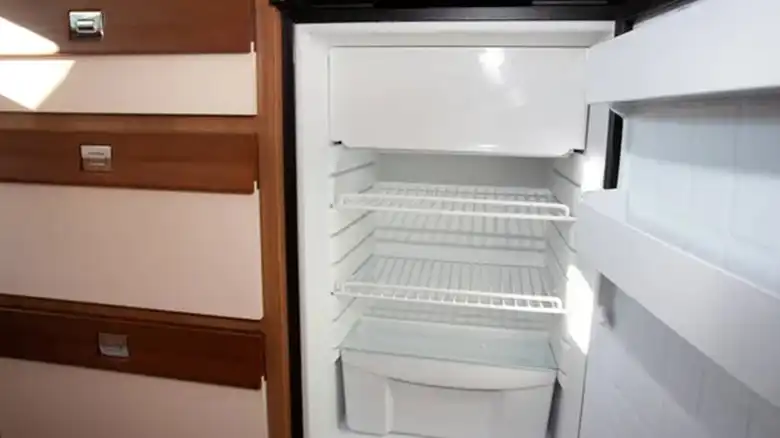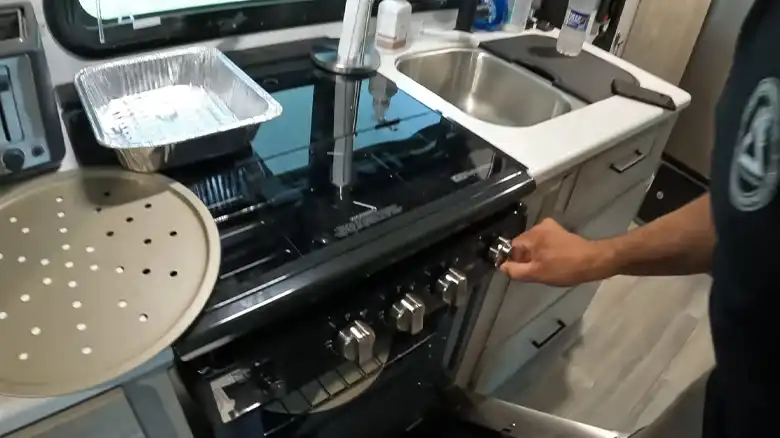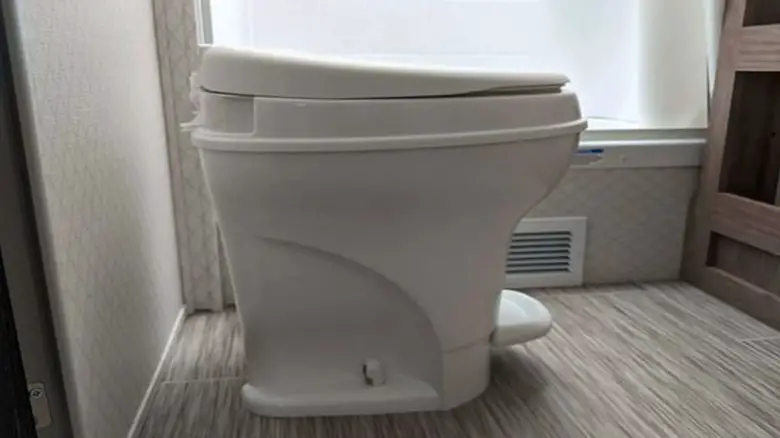As you travel in your RV, a malfunctioning fridge is an unwelcome challenge. It’s often caused by an ammonia level imbalance, disrupting the coolness of your drinks and the freshness of your food.
The solution to this problem, though, is well within your grasp. By learning how to check and regulate the ammonia level in your RV fridge, you can ensure a reliable and efficient mobile kitchen. We’ll provide you with a clear answer on how to tackle this issue. It involves a few simple steps.
You’ll learn how to safely prepare your fridge for testing, locate the crucial cooling unit, and use the necessary tools like ammonia test strips to assess the ammonia level. But that’s not all. We’ll also discuss the essential step of interpreting the results accurately.
Concerned about food and drink freshness on your RV journeys? I’ve got you covered. Discover the secrets of RV fridge ammonia levels and equip yourself to maintain a cool, efficient, and hassle-free mobile kitchen. Keep reading.

Step-by-Step Guide for Testing Ammonia Levels
Discover how to troubleshoot your RV fridge issues and maintain its efficiency. This step-by-step guide ensures a reliable mobile kitchen.
- Safety First
Prioritize safety before checking ammonia levels. Emphasize proper ventilation to prevent ammonia fumes, making it a crucial initial step in the process.
- Preparing the Fridge
To get started, power off your RV fridge. It’s like giving it a little break before the test. Ensure you disconnect any electrical sources, so you’re safe while working on it. Think of it as the calm before the storm—a necessary preparation for your RV’s cooling system.
- Locating the Cooling Unit
The next step is uncovering the cooling unit’s secret hideout in your fridge. Typically, it’s lurking at the back. But don’t worry; we’ll provide visuals to assist you in identifying it. Think of it as a little treasure hunt within your RV fridge.
- Using an Ammonia Detector
An ammonia detector is like your trusty sidekick. It can quickly sense any ammonia leaks and help you stay safe. You’ll want to have this gadget on hand to make sure everything is running smoothly.
- Use an Ammonia Test Kit
If you prefer the hands-on approach, an ammonia test kit is your go-to tool. It allows you to take matters into your own hands and perform the ammonia check yourself. It’s like having your own mini-laboratory right in your RV.
- Check Ammonia Levels with Litmus Paper
If you want a simple and quick way to test ammonia levels, litmus paper is your best friend. It’s like the magic wand that can reveal the secrets of your RV fridge’s cooling system.
- Testing the Ammonia Level
Now comes the heart of the mission. You’ll use ammonia test strips to check the ammonia level thoroughly. We’ll provide a detailed procedure for this step and include essential tips for reading the results accurately. It’s where the detective work gets exciting.
- Interpreting the Results
Once you’ve conducted the test, it’s time to interpret the results. We’ll guide you through the process, explaining how to differentiate between normal and abnormal ammonia levels in your RV fridge. It’s like deciphering a code, and you’ll be the master of it.
By following this step-by-step guide, you can ensure that your RV fridge’s ammonia level is in check, keeping your food fresh and your adventures cool. So, gear up and get ready to be the hero of your RV kitchen!
Why It’s Important to Monitor Ammonia Levels?
Monitoring ammonia levels in your RV fridge is essential. It’s the key to maintaining efficient cooling, preventing food spoilage, and ensuring a worry-free journey on the road. Don’t overlook this critical aspect of your mobile kitchen’s performance.
- Highlighting Potential Issues
While you might not ponder RV fridge ammonia levels daily, they’re vital for a top-notch mobile kitchen. Neglecting them can lead to issues like a sudden fridge breakdown, resulting in spoiled milk, melted ice cream, and limp veggies – far from ideal during your travels.
- Impact on Refrigerator Performance and Food Safety
It’s not just about spoiled food; an ammonia imbalance affects your RV fridge’s performance. It may struggle to stay cool, make odd noises, and pose safety concerns. High levels are hazardous, while low levels risk food safety – a situation no one wants on the road.
So, keeping a close eye on your RV fridge’s ammonia level isn’t just a matter of convenience; it’s about ensuring a smooth and safe journey on the road.
Essential Tools and Equipment for Testing
Having the right tools is crucial for checking your RV fridge’s ammonia levels and ensuring it operates effectively.
- Safety Goggles: Prioritize safety with ammonia. Safety goggles shield your eyes from harmful splashes and fumes, ensuring a secure process.
- Ammonia Test Strips: Ammonia test strips are essential, providing accurate results for checking and maintaining your fridge’s ammonia levels.
- Flashlight: A quality flashlight guides you in navigating tight, dimly lit RV fridge spaces during maintenance.
With these tools in hand, you’re all set for a smooth ammonia level check to keep your RV fridge running smoothly.
Safety Guidelines for Handling Ammonia
Checking your RV fridge’s ammonia level is like being a kitchen detective. It’s crucial for keeping things fresh on the road, with safety as your partner.
- Discuss the importance of safety when dealing with ammonia
Safety is vital in checking ammonia levels. Ammonia is like a secret agent in your fridge, important yet potentially harmful.
- Explain the necessary protective gear and handling procedures
Prioritize safety by ensuring good ventilation, and wearing goggles and gloves. If new, consider professional help; if not, use ammonia test strips for safety.
In your RV journey, safety should always be your sidekick. So, let’s get those safety goggles on and ensure that you and your mobile kitchen stay in tip-top shape. Safety first, detective work second!
FAQs About Ammonia Levels in RV Fridges
Can I Test Ammonia Levels in My RV Fridge Myself?
Yes, you can perform a basic ammonia level check yourself using ammonia test strips, but exercise caution and follow safety guidelines.
How Frequently Should I Check Ammonia Levels?
It’s recommended to check the ammonia level every 3-6 months to ensure optimal performance and prevent issues.
What Are the Symptoms of Ammonia Imbalance?
Common signs include reduced cooling efficiency, unusual noises, and the presence of an ammonia odor.
Where Can I Locate the Cooling Unit in an RV Fridge?
The cooling unit is typically located at the back of the fridge, accessible from the exterior of the RV.
What Safety Measures Should I Follow During Testing?
Wear appropriate safety gear, work in a well-ventilated area, and disconnect all power sources to minimize risks.
Are Generic Ammonia Test Kits Reliable for RV Fridges?
It’s best to use ammonia test strips specifically designed for RV fridges to ensure accurate results.
What Are the Recommended Ammonia Levels for RV Fridges?
The ideal ammonia level can vary, but it’s generally recommended to maintain a level between 300 and 400 ppm (parts per million).
What Steps Should I Take If Ammonia Levels Are Low?
Consult your fridge’s manual or a professional technician to address the issue and prevent further damage.
How Can I Prevent Future Ammonia Imbalances?
Regular maintenance, proper ventilation, and avoiding extreme temperatures can help prevent ammonia issues.
Is DIY Ammonia Replacement Safe for RV Fridges?
Ammonia replacement or refilling is a complex task that should be left to experienced RV fridge technicians for safety and efficiency.
Conclusion
To wrap up, understanding how to check ammonia levels in your RV fridge is vital for a well-functioning mobile kitchen. By following our guide, you’ll ensure a more efficient and longer-lasting refrigerator, enhancing your RV adventures. Prioritize safety, and routine checks to avoid costly repairs. If you have questions or need clarification, feel free to leave a comment. Thanks for reading, and may your road trips be safe and enjoyable!


